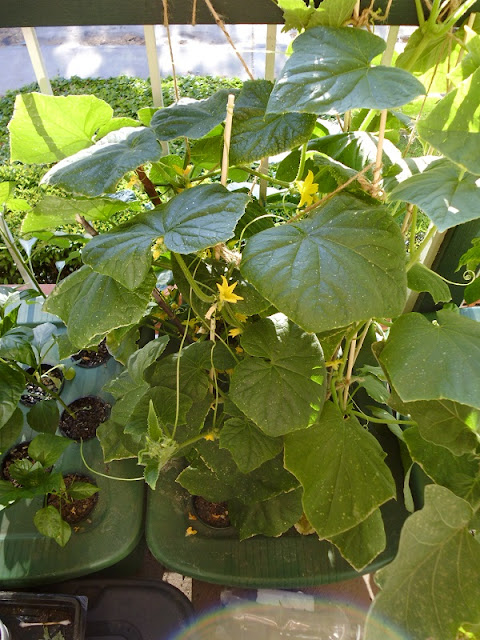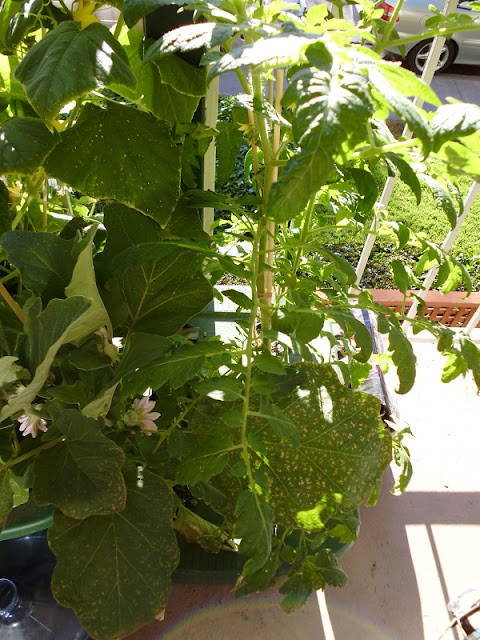PLANT SPACING
As previously stated, each of the grow sites (the net pots) are spaced at approximately 6" to 8" apart. This is adequate for smaller crops like lettuce, which I initially envisioned planting in it. I found out that tomatoes, peppers, eggplant, and cucumbers all grow extremely well in the system. Now from my observations, the roots tend to grow vertically down from the plant base and not interfere with the other plant roots nearby. However, the same cannot be said about the above ground portion of the plants. As said on seed packets, the tomato plants can spread out to cover 1-4 square feet, larger than the above ground system size. This causes leaves of larger plants to block smaller plants, stunting their growth. I had this happen with the peppers.
Now an easy solution for this problem is to not grow 6 large plants in a bin. I'd limit any new cucumber, tomato, eggplant, etc plantings down to 3 per bin. The other 3 slots can be filled with a variety of heat tolerant lettuce or similar small plant. Alternatively, once the plants have consumed a fair amount of water, rotating the bins is an option to put the smaller plants in more sun. This can be difficult if support structures are tied to permanent objects.
Now an easy solution for this problem is to not grow 6 large plants in a bin. I'd limit any new cucumber, tomato, eggplant, etc plantings down to 3 per bin. The other 3 slots can be filled with a variety of heat tolerant lettuce or similar small plant. Alternatively, once the plants have consumed a fair amount of water, rotating the bins is an option to put the smaller plants in more sun. This can be difficult if support structures are tied to permanent objects.
SUPPORT/TRELLISING
Now this is an oversight that I did not fully plan for. Plants as mentioned above tend to need support as they grow large. I first tried staking with simple BBQ sticks to support the main stem. I soon realized that these plants need a lot more space and support. An external support structure is needed to support larger plants or else they will sprawl all over the ground (as witnessed with my cucumber plants) or fall over (my tomato plant almost did this). Support can be rigged up with items around the bins (such as balcony fencing or anchors in nearby walls) or with a free standing PVC pipe structure. Elaborate trellising of any kind makes it hard to inspect and maintain the water reservoir. Additionally, any animals that crawl around the area might get curious and try to climb the support structures, potentially causing collapse.
REFILLING THE RESERVOIRS/DROWNING PLANTS
As the plants grow larger, the water reservoir will obviously drain. Now the obvious solution here is to just refill it with water. Wrong! In Dr. Kratky's paper he published on the subject, he states that plants are "terminated" after the water reservoirs run dry. He used much larger reservoirs for single plants than I am using for 3+ plants. Cucumbers are the most thirsty plants that I have tested, draining the tub nearly dry by the time they started to produce. So why are the plants terminated once the reservoir runs dry? Some do not respond favorably to an increase in the water level. I added about 6 gallons worth of water back to the cucumber bin and all the plants wilted away within 2 days. I have no idea if they will recover, but death of all the plants seems likely. This happened because cucumber roots are extremely sensitive to being moved or agitated. The addition of new water simulates drowning and deprives the roots of oxygen.
How can I prevent this from happening again? One option is to plant less cucumbers/bin, leaving more water for each individual plant. Another possible option is to try to fill the bins over the course of a week instead of all at once. Spreading out the water level height increase might give the roots more time to accept the new water and not "drown".
To sum all my problems and solutions up:
How can I prevent this from happening again? One option is to plant less cucumbers/bin, leaving more water for each individual plant. Another possible option is to try to fill the bins over the course of a week instead of all at once. Spreading out the water level height increase might give the roots more time to accept the new water and not "drown".
To sum all my problems and solutions up:
- Plants spread out too far -----> Put less plants/bin
- Growing variety that needs staking -> Create support structure during transplant
- Reservoir running low ----> Let plants produce until dead or refill reservoir over time
- Plant is not growing ---> Bad nutrient solution/weather/roots aren't touching water/lack of sun




I like the simple method of this and I appreciate that you have shared the pitfalls! Staking for cukes & maters is always a necessity. I am very excited to try this method. The first info I saw as a 2 gal bucket buried. It suggested 2 gal as a min with only one plant. The burying had to do with retarding growth of algae in the sun. I hope to circumvent this issue with a black garbage bag as I'm not looking to bury a bucket. The same cannot be said for my ex-husband.
ReplyDeleteIf you are in a warm location, the black bag will heat up too much and kill the roots of your plants. Try a 5 gallon plastic bucket from Home Depot. They're only a couple bucks because their name is on them :> Orange shouldn't heat up too bad. If it does, find some cheap white paint and give the bucket a makeover..
DeleteHere is the link for above referenced info, in case you're interested. Also, please ignore the last comment. https://www.tool-rank.com/tool-blog/editorial/growing-tomatoes-and-other-vegetables-in-a-kratky-inspired-hydroponic-bucket-201405121639/
ReplyDeleteYou might also consider a float valve connected to a reservoir that maintains a 2-3" level of nutes after the plant has "drunk" the top 6-8"+. So you could use smaller bucket(s). Perhaps evem multiple buckets ...........Ken
ReplyDeleteaswater is used up plant grows air roots ,refill resivor do not cover air roots you will drown plant,
ReplyDelete